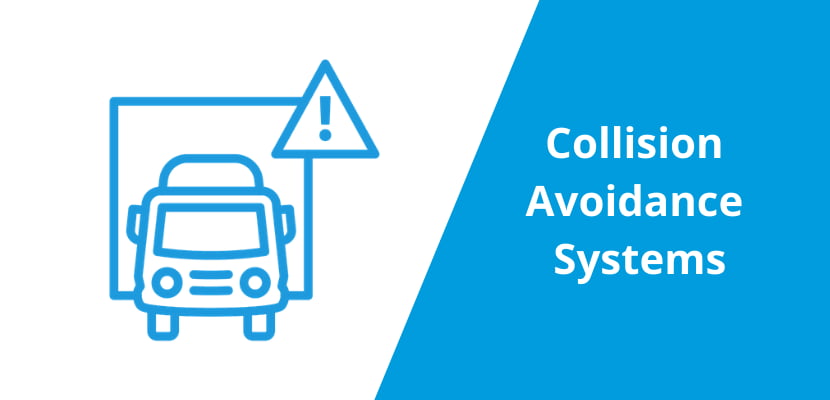What is a collision avoidance system?
A collision avoidance system, also known as a driver assistance system, is an in-vehicle technology designed to prevent or decrease the severity of an impending collision. It does not typically have the features to help fleets predict when collisions are most likely to occur—this system is designed to prevent an incident immediately prior to it happening.
Automotive collision avoidance systems may include fleet dash cams, sensors, lasers, short- and long-range radar, GPS, and even AI and machine vision. These different technologies monitor and collect data about what’s going on around and within the vehicle.
If the inputs detect a forthcoming collision, a driver can be alerted via a sound, flashing light, vibration, etc. More advanced collision warning systems also initiate a response from the vehicle, such as applying partial or full braking force.
History of collision avoidance systems
In one form or another, vehicle collision avoidance systems have been around for decades. For example, GM’s Cadillac Cyclone XP-74 concept car, which debuted in 1959, included radar-based “proximity devices” that were designed to scan the road ahead and alert drivers of objects in its path.
In more recent years, technology like automatic braking, forward-collision alerts, and steering assistance has been adopted from high-end luxury cars and become standard in mainstream personal and commercial vehicles.
Because the vast majority of collisions are caused by human error, the interest and investment in developing collision prevention systems is only increasing. While the technology is getting better and better, it’s certainly not the only fleet safety system you should have in play. Keep reading to learn more about collision avoidance systems in cars and commercial vehicles.
Types of collision avoidance systems
Collision avoidance systems can also be leveraged as powerful driver training tools. The combination of technology features and alerts can improve driver awareness, assist the driver in maintaining safe driving behaviors, and intervene if the driver does not respond to a potential collision.
It’s important to note that collision avoidance systems are not currently advanced enough, or designed, to take full control of a vehicle from a driver.
Here are the common types of collision prevention systems:
- Forward collision warning (FCW), which includes impact alerts (IAs), following distance alerts (FDAs), and stationary object alerts (SOA)
- Lane Departure Warning (LDW)
- Pedestrian Detection System (PDS)
- Automatic braking system (ABS) or Automatic Emergency Braking (AEB)
- Adaptive Cruise Control (ACC)
- Vehicle avoidance systems
Are collision avoidance systems effective?
Yes, collision avoidance systems can be incredibly effective, but there are some caveats. Warnings from collision avoidance systems must be appropriate and timely—when they achieve this balance, they can help prevent accidents, as well as reduce distracted driving, improve safe driving behavior, and teach drivers how to identify problems before they unfold.
A recent study highlights the benefits of collision avoidance devices. Using U.S. police-reported crash data, the Insurance Institute for Highway Safety (IIHS) published a 2016 report stating that vehicles equipped with front crash prevention are much less likely to rear-end other vehicles.
The report found that “Systems with automatic braking reduce rear-end crashes by about 40 percent on average, while forward collision warning alone cuts them by 23 percent…The auto brake systems also greatly reduce injury crashes.”
Why fleets need more than just a collision avoidance system
While there is significant value to implementing collision avoidance systems to help with fleet management, a robust safety solution also incorporates technologies that can help you predict when the riskiest events are most likely to occur on the road. In short, to truly protect your business and drivers, you need a system that can help prevent collisions before they happen.
Lytx driver safety solutions are designed to help fleets get real, long-lasting results with minimal time and effort. Our driver-centric tools are the industry’s most advanced technologies to help predict and prevent collisions, protecting your team and bottom line.
Lytx’s machine vision and artificial intelligence (MV+AI) technology can help detect risky driving behaviors like distracted driving, seat belt misuse, rolling a stop sign, inattentive driving, and much more.
Drivers or fleet managers can be notified or alerted of these risky moments, and either self-correct or talk it over with their manager. Lytx offers much more than just a collision avoidance system—its powerful and efficient solutions can help improve driver safety and performance… quickly and easily.
Get all the benefits of a vehicle collision avoidance system and much more. Lytx’s machine vision and artificial intelligence technology can help detect and deter risk that leads to collisions. Contact us to learn more.
